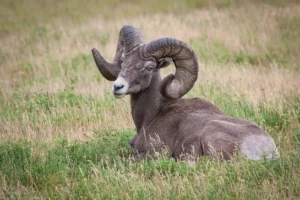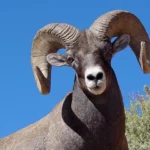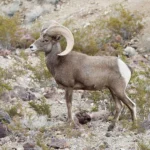Bighorn sheep are famous for their long and curved horns. What is their behavior in the winter season? Let us know more on this matter.
Bighorn sheep need a drier slope in the winter season as they face difficulties while walking in the snow. Their usual habitat consists of the grassy slopes of the mountain, and foothills of rocky cliffs and bluffs. They need that space where snowfall is not more than 6 inches annually.
Sage and willow are the food for them in the winter season but their main food is grasses and sedges.
Do bighorn sheep have wool?
Sheep are majorly known for their wool. Do bighorn sheep also possess wool? Let us discuss this topic.
Bighorn sheep do not possess wool. They have a brown thick covering around their body but it does not contain wool. Due to this, bighorns have less endurance to cold than the ordinary sheep. The coating of the body of bighorn sheep is more like a deer.

What do bighorn sheep do in the winter?
Bighorn sheep look for more sheltered valleys during the winter season as they do not walk well in the deep snow. They need a place where the snow is less and is also safe from certain predators. They can survive for a month without drinking water and they get the required electrolytes from their diet.
How do bighorn sheep stay warm?
Bighorn sheep are not great survivors in the winter season. They have certain adaptations for keeping them warm to survive in cold weather. Let us know more on this topic.
Bighorn sheep grow thick double-layered coats in each of the summer season to protect themselves from extreme cold situations. They generally have lush underfur. Some of the bighorns also have some thick layers of fat which also helps them to keep warm.
Bighorn sheep lose their winter coat after the winter season passes and grow again in the mid of the summer.

Do bighorn sheep migrate?
Recent studies have shown that bighorn sheep are migratory on average within native population, and also exhibit greater diversity in migration methods. Sheep within a single native flock may migrate short distances between regions or remain in the highlands all year round.
How far will bighorn sheep travel?
Bighorn sheep can travel up to 20 miles to 25 miles. They usually visit mineral licks during winter to maintain the mineral content of their body as they do not drink water while migrating. Bighorns have a maximum speed of 30 kilometers per hour and a spectacular climbing ability in the rocky terrain.

Where do bighorn sheep sleep?
Bighorn sheep rarely explore new kind of habitats. Now let us know in which place do they sleep.
Bighorn sheep sleep in the rocky and steep slopes of a rocky mountain. They choose this kind of rocky terrain for their nightlife because their outer body color blends with the color of the rock. The top of rocky rims also can be the place for their sleeping.
Are bighorn sheep nocturnal in winter?
Bighorn sheep possess some nocturnal activities in the winter though they are generally diurnal in nature. In the winter, they cannot roam outside in the thick snow and the fright of predators. Hence, they find food and roam freely in the nighttime during the winter season.
Usually, bighorn sheep are more active during the time of sunset and sunrise. Rams (Male bighorns) possess more nocturnal activities than Ewe (female bighorns) as they can roam alone.
Conclusion
The conclusion of this article is that the bighorn sheep do not have wool. They have a thick winter coat-like coating and they grow this coating in each of the summer season. Bighorn sheep are found in higher rocky terrain and some of them also can migrate during winter.




